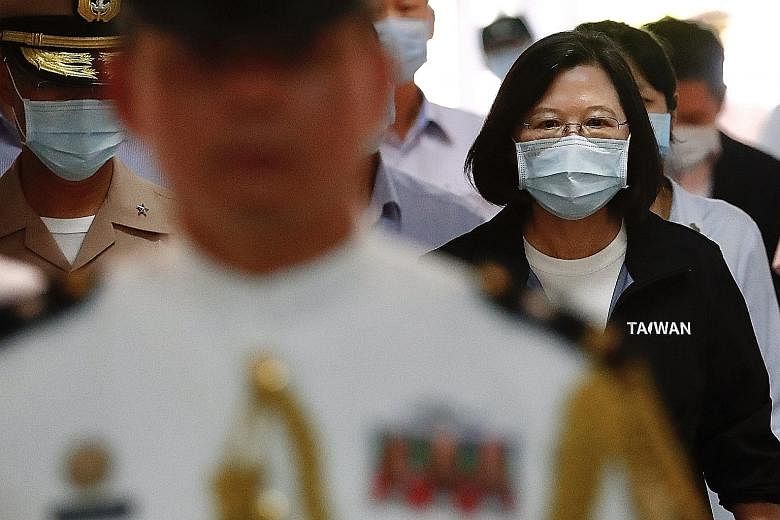KAOHSIUNG • Taiwan President Tsai Ing-wen visited a low-key but critical maintenance base for fighter jet engines yesterday, offering encouragement as the Chinese-claimed island's armed forces come under strain in the face of repeated Chinese air force incursions.
This month alone, China's drills have included its jets crossing the mid-line of the sensitive Taiwan Strait and exercising near the Taiwan-controlled Pratas Islands in the South China Sea.
Beijing regards Taiwan as a wayward province and has never renounced the use of force to bring the democratic island under its control.
Taiwan's air force has repeatedly scrambled to intercept Chinese jets. The flights have not been over the main island of Taiwan itself but have still ramped up pressure, both financial and physical, on Taiwan's air force to ensure its fighter planes are ready to go at any moment.
Visiting the Gangshan airbase in southern Taiwan's Kaohsiung, Ms Tsai received a detailed account of how the maintenance crew is making sure Taiwan's F-16 jets and other fighters are operating at peak performance. She appeared slightly taken aback when told the cost of one small component for the F-CK-1 Ching-kuo Indigenous Defence Fighter was NT$380,000 (S$18,000).
Speaking later to sailors at the nearby Zuoying naval base, Ms Tsai promised to be the strongest backer of the island's armed forces.
"If there was no backup or help from you all, the military's steadfast combat strength would be greatly reduced," she said.
Taiwan's air force is dwarfed by China's, and the strain of the multiple sorties on the island's armed forces has begun to show. The Defence Ministry this month said the "dramatic increase" in the threat level, along with the aircraft being "middle-aged", had led to a huge increase in maintenance costs not originally budgeted for.
Mr Saldik Fafana, 21, a trainee air force engineer at the Gangshan base, said he had noticed an impact recently. "There is more work," he told reporters.
Taiwan is revamping its fighter line-up.
The United States last year approved an US$8 billion (S$11 billion) sale of F-16 fighter jets to Taiwan, a deal that would bring the island's total to more than 200, making it the largest F-16 fleet in Asia.
Taiwan's Defence Ministry, in a report to Parliament last month, a copy of which was reviewed by Reuters, said China's flights over the narrow strait's mid-line were aimed at reducing Taiwan's response time. This has put "enormous pressure" on Taiwan's front-line responders, it said.
Chinese flights to Taiwan's south-west, including at night, are "an attempt to exhaust our air defences", the ministry added, warning that if these become regular fixtures, they will "increase our burden of response".
REUTERS

